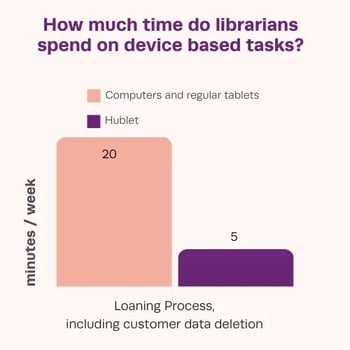Managing shared tablets in a busy library? We feel you. It’s not easy to keep everything running smoothly when you’re managing device lending, returns, user expectations, and the occasional tech hiccup. But here’s the good news: it doesn’t have to be this hard!
Let’s dive into the common challenges libraries face—and how self-service solutions can save time, reduce stress, and make your tablet management very easy.
The Problem: Why Tablet Management Feels Like a Full-Time Job
If managing tablets has ever felt more complicated than it should, you’re not alone. Here’s why:
- Manual Workload Overload: From lending tablets to wiping user data, traditional systems rely heavily on staff to do it all.
- Availability Struggles: Ensuring tablets are always charged, sanitised, and ready for the next user can feel like a never-ending task.
- Tech Expectations: Users want a simple, intuitive experience, but not everyone is tech-savvy—making it challenging to meet diverse needs.
And let’s be real—it’s not just libraries. Schools, healthcare facilities, and hotels all face similar issues when it comes to managing shared devices.
The Solution: Why Self-Service Tablet Lending Is a Game-Changer
What if your visitors could borrow and return tablets without staff needing to lift a finger? That’s the magic of self-service tablet lending systems.
Here’s how they simplify your life (and your staff’s):
- Fast and Independent Lending: Visitors grab a shared tablet from a sleek self-service station, use it, and return it—all without staff assistance.
- Automated Data Wiping: Each tablet is reset digitally after every session, ensuring user privacy and device readiness.
- More Time for What Matters: With less time spent managing devices, your team can focus on helping patrons with other tasks.
Real Talk: The Numbers Don’t Lie
A survey in Finnish libraries revealed that librarians spend, on average, 1.5 hours per week managing shared tablets. That’s over 70 hours a year spent on tasks like resetting devices and assisting users.
- Assisted Lending: Staff spend 75% more time helping customers and handling tasks like removing private data from shared devices.
- Self-Service Lending: The need for staff involvement drops to just 25% of the time as tasks like wiping user data are automated, allowing staff to focus on other important tasks.
Imagine what your team could do with all that saved time: programming more community events, improving other services, or maybe just finally having a moment to breathe.
Why Automation Is the Future of Tablet Management
Smart systems don’t just make things easier—they make things better:
- Efficiency: Automated processes handle the boring stuff like data wiping and lending, so you don’t have to.
- User Satisfaction: Visitors enjoy fast, hassle-free tablet access whenever they need it.
- Scalability: Whether you manage 5 tablets or 50, a smart system grows with your library’s needs.
Managing shared devices doesn’t have to be a full-time job. With solutions like Hublet Solution, you can automate the process, free up your team, and deliver a seamless experience for your users.
Because the less time you spend managing shared tablets, the more time you have to do what libraries do best—connecting people to knowledge, culture, and creativity. 😊






